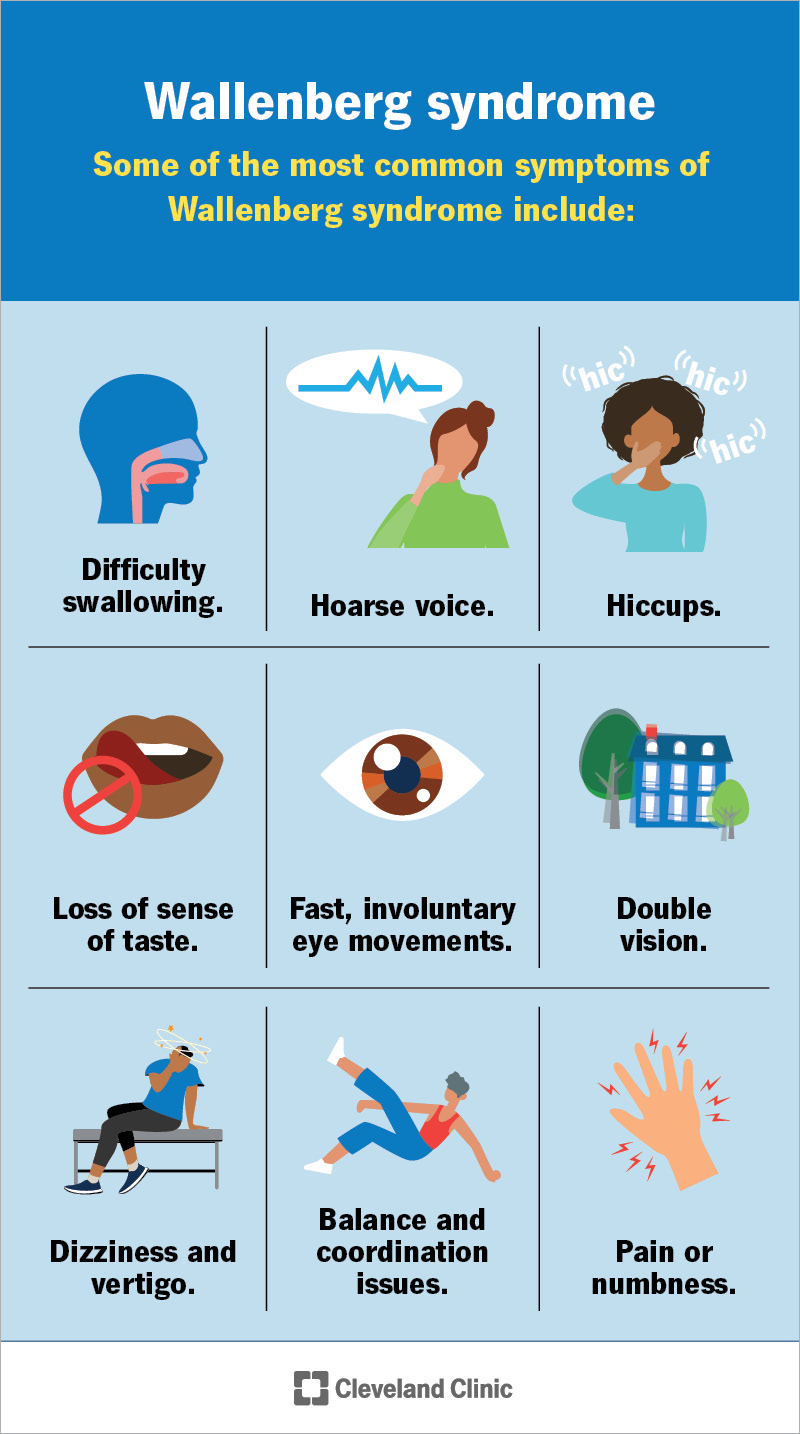Wallenberg syndrome is a neurological disorder that happens when something slows or stops blood flow to your brainstem. It causes symptoms like difficulty swallowing, balance issues and vision changes. Early treatment is crucial for the best outcome and can reduce your risk of complications.
Advertisement
Cleveland Clinic is a non-profit academic medical center. Advertising on our site helps support our mission. We do not endorse non-Cleveland Clinic products or services. Policy
Wallenberg syndrome is a neurological disorder that happens after an event that affects how blood flows to your brainstem, like a stroke or blood clot. It leads to symptoms like difficulty swallowing, dizziness and involuntary eye movements. It may make you feel as if everything you see is tilted. This can affect your balance and coordination.
Advertisement
Cleveland Clinic is a non-profit academic medical center. Advertising on our site helps support our mission. We do not endorse non-Cleveland Clinic products or services. Policy
You may hear your healthcare provider refer to Wallenberg syndrome as lateral medullary syndrome or posterior inferior cerebellar artery syndrome, as these are areas where damage can occur.
Treating the cause of Wallenberg syndrome quickly leads to the best outcome and reduces your risk of complications.
Wallenberg syndrome is the most common condition that happens after a posterior ischemic stroke. One study estimates that there are more than 60,000 new cases of Wallenberg syndrome diagnosed each year in the United States.

Some of the most common symptoms of Wallenberg syndrome include:
Symptoms may affect only one side of your body. For example, you could lose the feeling of pain or temperature on one side of your face but not the other.
Your symptoms may get worse (progress) over a couple of hours to days. Symptoms vary based on where damage within your brain or brainstem occurred.
A brainstem stroke causes Wallenberg syndrome. This can happen after:
Advertisement
Other less common causes of Wallenberg syndrome include:
You’re more at risk of Wallenberg syndrome if you:
Less common conditions that may be a risk factor for Wallenberg syndrome include connective tissue conditions like:
You may experience permanent changes after a post-stroke condition like Wallenberg syndrome, including:
A healthcare provider will diagnose Wallenberg syndrome after a physical exam, neurological exam and testing.
Your provider will look for symptoms that affect only one side of your body to pinpoint where there might be damage. For example, you may lose your sense of taste on the right side of your tongue. This tells your provider that you may have damage to the left side of your brainstem. Your brain works like a mirror, so the right side of your brain regulates the left side of your body and vice versa.
To confirm a diagnosis, your provider will offer testing, which may include:
Your provider may order other tests, like blood tests or an electrocardiogram, to rule out other conditions with similar symptoms.
Treatment for Wallenberg syndrome first focuses on removing the obstruction or blockage of blood supply to your brainstem. In the case of a stroke, your provider will quickly offer one or a combination of the following:
After treating the blockage, your provider will manage symptoms and/or complications. This may include:
If you experience chronic (long-term) pain with Wallenberg syndrome, your healthcare provider might recommend taking gabapentin. This is an anti-seizure medication that may help treat this complication.
Talk to your healthcare provider about any medications or supplements you currently take before starting a new medication. They’ll discuss the possible side effects with you so you can make an informed decision about your health.
There isn’t a cure available for Wallenberg syndrome at this time. With treatment, you can reduce your risk of complications, especially when diagnosed and treated at the first sign of a stroke.
Advertisement
Your healthcare provider will give you the most accurate information about your outlook. It can vary from person to person, depending on where the damage affects your brainstem and how severe it is.
You may notice your symptoms reduce over several weeks to months and you start to feel more like yourself before the stroke. But a stroke can leave permanent damage and could cause neurological changes that affect your day-to-day functioning. Treatment options are available to help you cope and adapt after a stroke.
You can’t prevent all cases of Wallenberg syndrome, but you can reduce your risk by:
Call 911 or your local emergency services number right away if you or a loved one show signs of a stroke like:
Wallenberg syndrome affects each person differently because the damage of a stroke is unpredictable. This can be a frightening experience for both you and your loved ones. While you might experience a few symptoms that gradually reduce over a few months, sometimes, complications happen. These can change how you feel and function on a daily basis.
Advertisement
It’s important that you contact emergency services right away if you notice signs of a stroke. Your healthcare provider will quickly diagnose and treat Wallenberg syndrome and its cause to prevent damage.
If you have any concerns about your condition, your healthcare provider will have the most accurate and up-to-date information to help you in managing your symptoms.
Advertisement
After a stroke, it’s essential to get treated right away. Cleveland Clinic’s stroke care specialists can help you manage recovery and improve your quality of life.

Last reviewed on 11/11/2024.
Learn more about the Health Library and our editorial process.